January 8, 2024
20+ Best Slack Apps and Integrations in 2024
Our team has been together for over 10 years, using Slack for a large part of that time. With this experience...

Slack is a powerful tool, and has been a game changer for the remote work revolution.
More than 12 million people use Slack every day. This includes Slack users in over 150 countries, from small startups to companies in the Fortune 100.
Yet a large number of these users likely aren’t using Slack to its full potential. There are a whole host of features, tricks and hacks with Slack that you can use to build incredibly efficient workflows, and boost productivity.
If you’re one of those people, don’t fret. We’ve put together some of the most useful Slack hacks, tips and tricks in this post, to give you everything you need to start doing more with your Slack account.
You’ll find there’s one thing in common with just about any highly productive person. They use keyboard shortcuts and hotkeys.
It doesn’t seem like it would make a big difference. But over time, the few seconds you save on each action really adds up.
Slack offers a huge list of intuitive shortcuts, to help you flow faster from task to task. Once you get used to them, you’re going to have trouble going back to life without shortcuts.
Here are some you might find worthwhile:
For a full list of keyboard shortcuts, check out this page in the Slack help center.
Try to practice using the shortcut for any tasks you perform often. Once you commit it to habit, you’ll find you work a lot quicker.
Slack also gives you a number of commands you can use to perform certain actions.
All you need to do is type “/” and the command into the message bar and hit enter. Here are the built-in commands that come standard with all Slack workspaces:
Most Slack apps also have their own slash commands.
Commit some of these commands to memory to further speed up your workflow.
You can improve your communication ability on Slack by learning different ways to format messages.
If a particular part of your message needs to stand out, or you need to make it easy for people to copy and paste a specific section of text, you can do this with Slack’s standard formatting options.
You’ll see these options above the message box – a quick hover over each of the icons will tell you what they do.

It includes the basic kind of formatting you’ll find in any word processor or text input, such as:
Bold text
Italics
Strikethrough
Create a hyperlink
Then you’ve also got a few additional types of formatting, which you might find useful:
Blockquote

Code
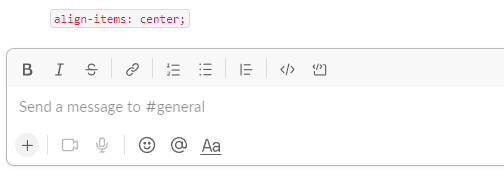
Code block

The “code” formatting is great for sharing lines of code, or passwords or logins, and making it clear exactly what characters someone has to copy and paste.
You can also use a Slack collapsible code block or Slack post if you need to share longer pieces of text or content, and make a comment about it in the same message.
All these formatting options have their own keyboard shortcuts. Some are standard across all programs (such as bold and italics), some less common. So if you’re often using code snippets, or lists, for example, learn the shortcut to speed up the time it takes to write clear and easy-to-follow Slack messages.
Sending a direct message to yourself is a pretty near Slack hack.
Unfortunately, you can’t send a message to your past self, telling you to hold out for more money in the interview process, or to bring the washing in before it started to rain.
What you can do is use this as a handy notepad for your future self.
Whenever a thought comes to you in passing, or you remember something that you’ll need to bring up later, send it to yourself in a message.

Make a routine of checking your messages a few times a day, in case there’s something in there you were supposed to remember or do.
It’s also a good place to draft up important messages, and make sure it looks right before copying and pasting in another Slack channel or message thread.
You can even share messages from other channels with yourself, if someone makes a comment you want to save for yourself. Just hit the “Share” button that appears when you hover over the message, and choose yourself from the dropdown menu.
Another option for saving critical messages to come back to is to use the “Saved items” feature.
With one click, you can add any message to a special section (for yourself only), allowing you to easily find it and review it whenever you need.
Just hover over the message and click “Add to saved items”. The message will be highlighted, and the icon will turn red.
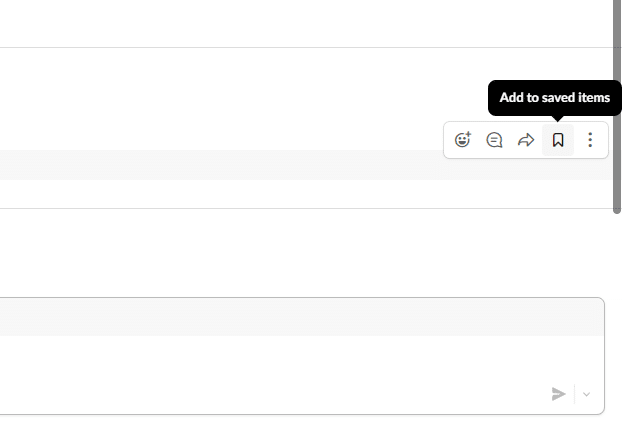
Hit it again to remove it from your saved items.
This is great for creating a to-do list in Slack. Whenever you get asked to do something, save it. Then go through your saved items regularly, and remove an item when you complete it.

You can even add your own items to the list, by sending messages to yourself and saving them.
You could also just use this to save any important information you need to be able to access quickly, without having to search or dig through a channel to find.
Reminders are another smart feature that helps with productivity. You can set reminders for yourself, a Slack user, or a Slack channel.
Slack will send a notification to whoever is specified, at the specified time.
This is another good way to set up a to-do list for yourself, or to keep other team members on track to complete tasks on time.
You can set reminders a few different ways. First, on any message, hit the three dots in the hover menu, and click “Remind me about this”. Then choose when you want to be reminded.
You can also type /remind in the message bar, and choose “Set yourself a reminder”. Then just fill out the time and details of the reminder.

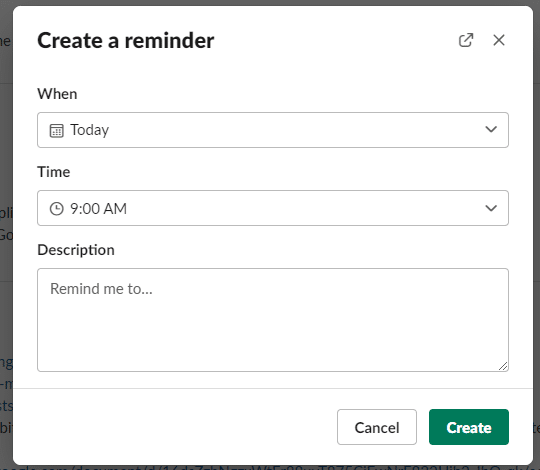
Finally, you can do it all directly in the message bar. Type /remind, followed by who (“me” to remind yourself, “@[name]” for someone else, or “#[channel]” for a whole channel), what (e.g. “turn in project analysis”), and when (e.g. “in 1 hour”).
For example:
/remind #general turn in project analysis in 1 hour

At any time you can view all the reminders you have set, delete them, and mark them as complete. This makes it a nice kind of to-do list. Just save your to-do list items as reminders, and hit /remind list in the message bar to view your reminders and check them off when complete.
If you’re like me, you probably spend too much time opening different Slack channels, looking for a particular message or conversation.
You might also get overwhelmed by clutter every time you open Slack, and get distracted.
If that’s the case, you’ll definitely improve productivity by customizing your channel settings.
By default, your channels are sorted alphabetically, and all the channels you’re a part of will show up in the left sidebar.
You can mute channels that aren’t important (but that you don’t want to leave completely). This will move it to the bottom of the list, and it won’t light up with new messages, unless you’re mentioned.
If your workspace is on a paid plan, you can sort Slack channels into separate groups, too. This lets you group channels by project, or by type (e.g. group all alerts or notification channels together), or by anything that works for you.

To do this, hit the three dots next to “Channels”, and hit “New section”. Then move channels into the section you want.
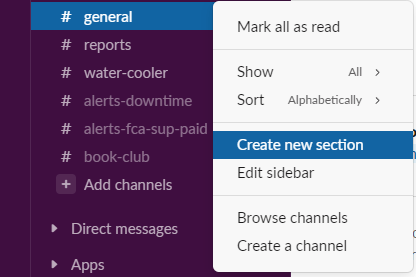
This will only change how the sidebar looks for you – so don’t worry about messing it up for anyone else.
If you’re not on a paid plan, you can still group important channels by “Starring” a channel. Go to the channel details section, and hit the star icon (“Star channel”). Any of your starred channels will appear at the top, so you can make sure you check the most important messages first.
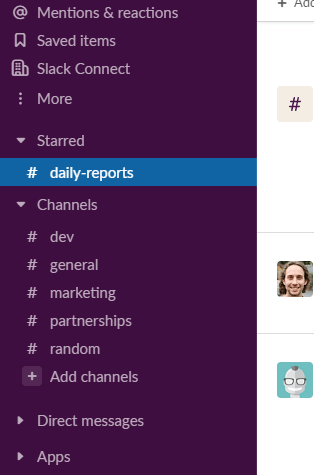
A lot of the time you’ll have announcements or instructions, which people should be able to come back and refer to whenever they need.
If you just leave this as a message in a channel, it’ll get lost in the shuffle. So for any critical or evergreen information, use the “Pin” feature.
This will highlight the message in the channel, and let anyone view it with one click, by clicking the pin icon at the top of the channel.

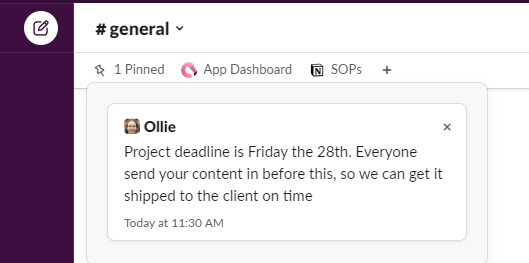
Similarly, you can add a bookmark to a channel. This is an external link, which will also be pinned to the top of the channel.
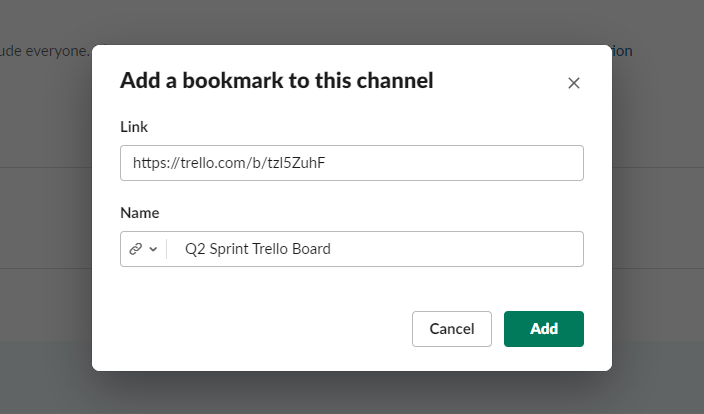
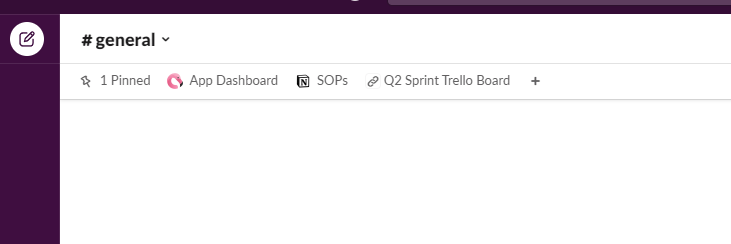
You can even create folders with multiple bookmarks. It works just like the bookmark toolbar on your browser.
This is an awesome way to keep any important links visible for everyone – such as SOPs, tools, or anywhere else your team may need to go outside of the Slack interface.
Another call for anyone to raise your hand if you’re like me, and didn’t even realize there was a search bar in Slack.
It kind of blends into the UI – but once you realize it exists, it will change your life.
The search function is very powerful if you know how to use it. There are a lot of ways you can filter searches, to find the right message or file, without having to go channel digging.
You can search by messages, files, channels, or people. And you can limit your search to a specific channel, or a specific person – or to a message from a specific person IN a specific channel, in a specific date range.
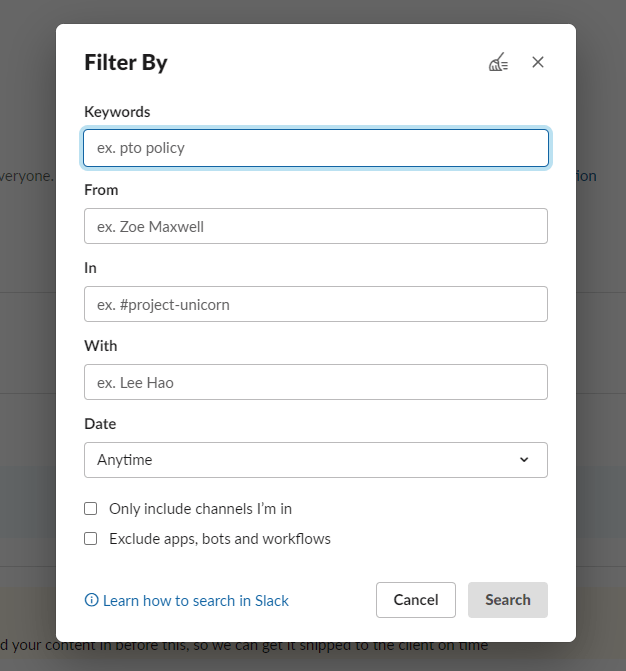
Do this by hitting the filter icon on the search bar, or (like anything in Slack), just type the parameters directly.
E.g. “PTO update from:[username] before:[date] and after:[date] in:[channel]”.
Another cool thing you can do is set it to exclude certain channels from showing in search results, in your workspace preferences.
When you start making it a habit to use the search function, think about it ahead of time by using keywords in your post that you know you’ll think to search for in the future.
This will help you quickly and easily find anything, as soon as you need it.
One of the best Slack hacks is simply to silence Slack every now and then.
Slack is great for staying connected with everyone, but sometimes you need to disconnect, and devote your entire attention to a single task.
That’s what “Do Not Disturb” mode is for. Switch this on when you’ve got deep work to do, that requires your focus.
Your profile in Slack will show that you’re away, so your team members will know you’re temporarily unavailable. It will also pause notifications during this time.

People will still be able to send a notification to you if it’s urgent. Your profile will show that you’re in DND mode, but they’ll have the option to notify you anyway.
For some, if your company allows, you can simply close Slack, and keep push notifications on your mobile device disabled whenever you need to focus on deep work.
However, for some people, it’s important to their job to stay connected. You may need to stay on Slack during work hours, and have mobile notifications on.
For these people, it’s just as important to set times aside to block notifications, to help you focus. It’s also vital to set up your non-working hours, so you can set up boundaries between work and home, where you don’t get notifications about work outside of working hours.
You can also pair DND mode with custom statuses that keep your team in the loop with what you’re doing, and when you’ll be available.
By default, your Slack status will show as a green circle next to your name – indicating you’re active – or an empty circle, meaning you’re away.
Besides that, there’s not a lot of information available for your fellow team members.
It’s much better if you use your status to communicate. You can indicate that you’re in a meeting, doing deep work, out sick, at lunch, traveling… basically anything.
You can set up when to clear your status (e.g. for your lunch break, it could go back to active after 1 hour), and set whether you want to pause notifications or not.
Another cool thing is the ability to set default statuses in your Slack workspace options, with default settings on when that status is cleared.
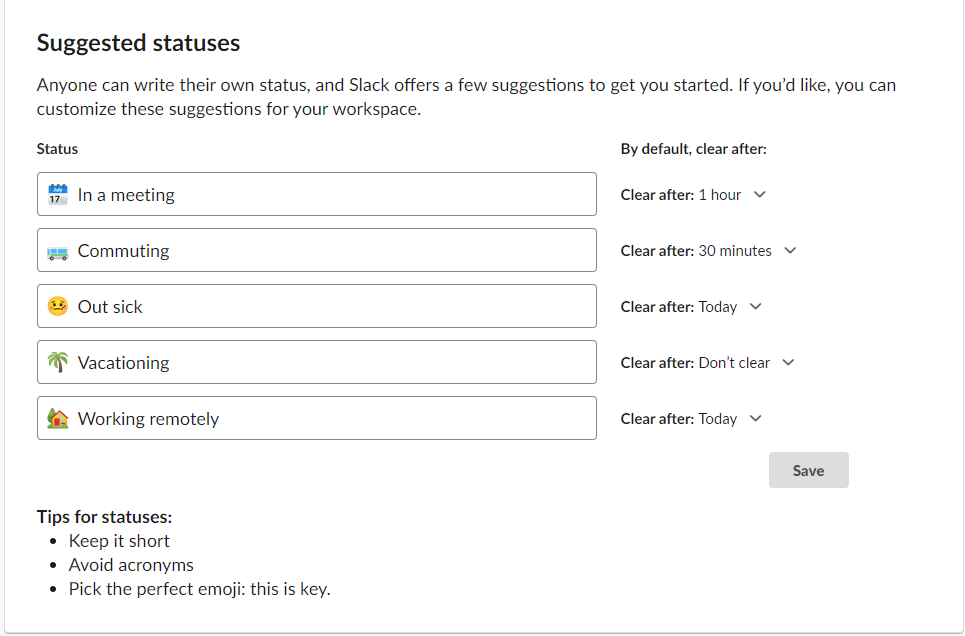
One of the challenges of remote work is the disconnect between team members, and not knowing where other people are and what they’re doing. But by using custom statuses, you can keep everyone on the same page, and make your Slack workspace feel much more like a virtual office.
Slack notifications can derail your day, and make you dread opening the Slack app – or they can work for you.
With the default notification settings, you get notified about new direct messages and Slack mentions. So if someone messages you, or mentions you (or @channel/@here) in a channel you’ve joined, you’ll get a notification and a big red badge shows up.
This might work for you. It might not. The key to mastering your notifications is to know what works best for you.
For some, these notifications come in all the time, and often aren’t urgent. The constant sound of Slack notifications, in this case, can become a real drain on your attention.
If this is you, you might want to play around with the notification sound, to choose a sound that’s less invasive. Alternatively, turn off sounds from notifications, or make use of DND mode more often.
On the other hand, you might want to get more notifications. If you fit in this category, you can set it up to notify you for every message in a particular channel.
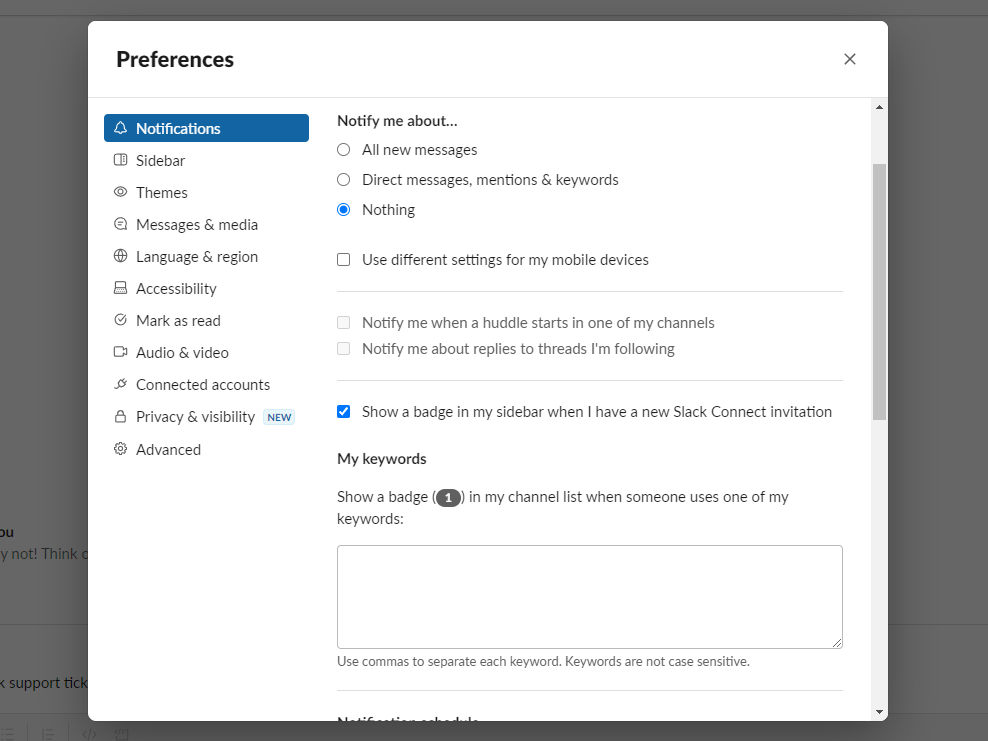
You can customize your notifications for each specific channel, too, so if you want to mute all notifications from one channel, but turn them on for every message in another, you can do that.
Another super cool thing you can do is set up keyword notifications.
By default, this is turned on, but there aren’t any keywords set up until you specify.
You can do this to get a notification whenever someone mentions a specific topic that’s relevant to you. Every time someone says “guest post” in the #outreach channel, for example.
This can be really powerful if you set it up in a way that works for you.
You probably use other tools or platforms as part of your daily workflow. You can make that workflow run a lot more efficiently by integrating them with your Slack workspace.
Just about every major tool today has a Slack bot, that lets you do anything from viewing updates within a Slack channel, to actually using the tool without switching platforms.
I can’t do without the HelpScout and Trello integrations. We set up an “alerts” channel with the HelpScout integration attached, which gets all new support tickets or replies to tickets. The Trello integration sends messages to another channel when a card is updated.
The Google Calendar integration is another incredibly useful one, for keeping your workspace and schedule in sync.
Other popular tools you can integrate Slack with include:
There’s usually no extra cost to use these integrations, so it makes sense to bring these into your workflow.
Alongside these tools that offer Slack integrations are purpose-built apps for Slack that let you do powerful things inside of Slack.
These apps can do amazing things for your business.While you can do a lot of cool automations with regular Slack features, it doesn’t come close to what third-party Slack apps can do.
You’ve got Geekbot, which helps you run asynchronous standup meetings and get daily reports from your team.
Simple Poll, which is an awesome way to run polls and surveys within your team.
And our app – Flamingo – which is the easiest way to request, approve and manage your team’s time off, again, without leaving Slack.
Check it out in the Slack app directory.
If you’re not using apps, you’re missing out on a big part of the power of the Slack platform.
For the final entry in our list of Slack hacks, you can create your own custom actions and tweaks to make your Slack workspace work perfectly for your team.
In your workspace settings, under “Customize”, are a couple of things to set up for your workspace.
You can set emojis as “one-click reactions” on posts. The reactions you set will show on the bar above the post when you hover it, letting people quickly and easily respond, where a more detailed response isn’t necessary.
If you want to take your AI-powered awesomeness to another level, set up some Slackbot responses. With this, you can set up an automatic reply whenever someone asks a question or mentions a keyword.
Use this for any FAQs, or automated responses for when people are looking for a particular document or link.
For example:

There’s a lot of fun and useful things you can do with the Slackbot. Be sure to try it out!
As you learn more about Slack, you’ll find it allows you to do amazing things to boost productivity and improve your workflow.
Not all of these Slack hacks will be relevant to you. You might be fine with the stock notifications, for example, or the default channel listing.
Yet a couple of the hotkeys or slash commands we shared in this post could do wonders for your daily workflow.
Almost everyone can benefit from simple Slack hacks like saved items and Slack reminders, too.
Whether you use Slack on desktop, the web app or mobile apps, try some of these tips, and see if they help your daily productivity. Don’t forget to check out the powerful things you can do with Slack apps as well, to take your Slack world to the next level.
Flamingo makes managing your team’s paid time off a breeze.